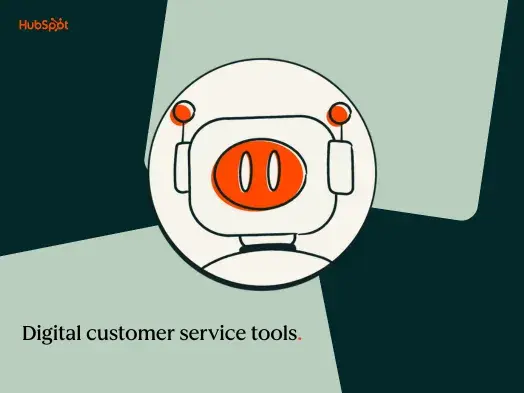Customer Service Tips HubSpot Reps Swear By
1. Solve for the customer.
At HubSpot Support, we have a saying: “Solve for the customer’s needs, not your own.” This mantra leads our support team and reminds our reps how to approach each interaction with our customers.
Rather than looking for shortcuts or handing the case off to another rep, our team is expected to be as invested in the situation as the customer. This means looking for long-term solutions that foster customer success, not quick fixes that will require more attention later.
Additionally, Customer Success Manager Sierra Howard encourages anyone in a service role to find empathy when dealing with customers.
Howard told me, “Put yourself in your customers’ shoes and be personable. You want to ensure that your customers don’t feel as if they are being treated as just another number.
Howard suggests that reps take time to really think about how they can help solve customer problems, how the customer could be feeling, and what value you could add from your interaction with them.
“It’s always important to be personable and build rapport so they feel heard and understood.” She adds, “For instance, I always try to find common ground where I can, and use a customer’s name in conversations so they feel as though they are getting a personalized and warm experience when working with me.”
2. Let the customer know you’re on their side.
Remember the last time you had a really good, effective conversation with a service rep? I’m willing to bet one of the main reasons you felt good afterward was the rep’s ability to make you feel like you were on the same team.
In customer service, it’s critical you show the customer you’re on their side when tackling a problem.
As HubSpot’s Customer Success Manager Christina Vuong puts it, “Being able to tell the customer that you’re on the same page and working collaboratively is incredibly important for building rapport and trust. I often approach conversations by using ‘we’ language, e.g., ‘We will figure this out together’ or ‘I am on your team here.’”
Vuong adds, “Their problem is now your problem. It’s important to keep in mind how urgently you would want the issue resolved if you were personally experiencing it.”
A lot of negative emotions can be diminished if a customer feels like they’re working with someone who cares equally about the outcome.
As Vuong notes, “Working collaboratively with customers removes a lot of frustration and friction between yourself and a customer if the customer feels like you’re a barrier to their success. Let them know you’re as invested in their roadblocks and concerns as they are, and team up.”

3. Set and manage expectations.
It can be tempting to say ‘yes’ to a customer at any cost, but this can lead to frustration and distrust down the road if you can’t actually meet those expectations. For this reason, it’s vital in customer service that you take the time to set appropriate and realistic expectations with your customers.
HubSpot’s Strategic Account Manager Fernanda Moreira Rodrigues provides examples for when not setting expectations could get you into trouble.
For one, she says, “If you’re still investigating the problem that caused what the customer is reporting, let them know that you are in the process of finding the answer and that you will get back to them in a certain time frame (make sure you give a realistic time).”
After that time, she notes, if you haven’t found the answer, let them know that you’re still working on it.
“Letting the customer wonder whether you’re working on it or you simply forgot their case can generate a lot of friction,” she says.
Alternatively, she adds, you want to be upfront about the services you can and can’t provide. You’ll want to point your customers in the right direction as soon as possible, rather than trying to fix a problem yourself if you know you don’t have the bandwidth or resources to handle it. For instance, perhaps a solutions provider or vendor is more equipped to deal with your customer’s issue than you are.
As Rodrigues tells me, “A lot of people lose too much time trying to solve problems they know in the end they can’t personally solve, so it’s better to set the right expectations so the customer can have their problem solved sooner rather than later.”
HubSpot Customer Success Manager Jen Berenguer agrees with this sentiment, telling me, “The most important thing a support rep can do for clients is manage their expectations. When I get support escalations, they’re often worried because the rep hasn’t responded to the client even though the rep is investigating the ticket.”
Berenguer adds that it’s important support reps tell clients why something can’t be done.
For instance, she says, “It’s very different telling a customer, ‘You can’t mention people on LinkedIn personal posts from within our product,’ versus saying, ‘Our product won’t allow you to mention people on LinkedIn personal posts because the LinkedIn API won’t allow our system to develop a functionality like that.”
Ultimately, when you’re in any customer-facing role, it’s critical you set and manage a client’s expectations to ensure you’re not creating a sense of distrust when you agree to something you can’t follow through with.
4. Leverage emotional intelligence.
Emotional intelligence is an important skill that customer support reps must develop in their careers. It refers to one’s ability to interpret and decipher other people’s emotions and respond to them in a constructive manner. Perfecting this skill will help your customer support reps quell frustrated or impatient customers and prevent escalations to your customer success team.
For example, some customers are less patient than others. These customers can sometimes seem pushy or over-demanding, but someone with strong emotional intelligence would recognize that these customers have immediate needs.
Customers don’t want to off-put your support team, but they will prioritize time-sensitive needs over being patient with an indifferent support rep. Leveraging emotional intelligence in these cases will help your team focus on fulfilling the customer’s goals rather than on the customer’s behavior.
5. Avoid making apologies.
This may seem counter-intuitive, but some of the best advice I ever received in support was to stop apologizing for roadblocks I had no control over. No matter how sincere I tried to be, customers didn’t really care about my apology. They just wanted their problem fixed. So, rather than apathetically apologizing time and time again, I began thanking customers for their patience instead.
It was during this experiment that I learned how powerful avoiding apologies can be in a customer service setting. I realized that every time I apologized, I was openly admitting to the customer that there was a problem.
Even if it was a minor mistake, I was giving the customer permission to be upset with me because I was acknowledging the flaw in my customer service.
By thanking customers, I was still taking responsibility for the mistake but prioritizing resolution. If the customer was still frustrated with the issue, my response appeared more confident, which made it easier for me to de-escalate the interaction.
It’s much easier to convince customers that you’re in control of the situation when you’re not apologizing every few moments.
6. Listen, and ask your customers questions.
Customer service is all about communication — and a key aspect of communication is listening.
Being able to actively listen to your customers gives you a leg up as a support rep. If you’re multitasking, it can be difficult to arrive at the root cause of a client’s problem, which can end up making your job harder, not easier.
As EMEA Customer Specialist Alnaica Augustave told me, “Listening is a major asset for customer support reps in order to meet customer needs. It’s important to listen and understand the problem by asking questions. Using theFive Whys Method when asking questions can drive towards the root cause of the problem and support the customers effectively.”
Augustave adds, “For instance, you may have customers who have difficulty expressing their problems, so it’s up to customer support to be able to rephrase and define the cause of the problem to determine why the customer is having this problem.”
Augustave says it’s necessary to play detective. You may have to ask “‘Who is experiencing this problem?’, ‘Where is the problem?’, and ‘What steps has the customer done so far to arrive at this issue?’ Those questions guide your investigation to understand the customer’s problem,” Augustave says.
HubSpot Customer Success Manager Patrick Shelley seconds this notion.
He told me, “Active listening is one of the most important skills in providing a great customer service experience. In many instances, service professionals are quick to provide a solution without fully understanding the context and desired outcomes of the customer’s unique situation.”

For instance, Shelley notes, if someone asks for advice on how to generate more leads, he would have to first find out what they have already tried, what their desired outcome is, and what their biggest obstacles.
“Understanding context and goals are essential to developing a customized and valuable solution for the customer. One rule that I try to adhere to is always asking at least one clarifying question before providing a solution,” Shelley says.
7. Use positive language.
The vocabulary and tone your team uses can steer the course of the conversation with a customer. So, it’s important to focus on using positive language because it encourages a better customer experience. By using positive language, your team can prevent escalations by demonstrating their confidence in resolving the customer’s issue.
For example, let’s say your rep is working with a customer on the phone, and they just can’t seem to figure out the problem they’re facing.
After 10 minutes of back-and-forth questions, the customer tells them they’re getting “a little annoyed” with how long the call is taking. If your rep responds with, “I understand this is very frustrating,” they’re escalating the issue in the eyes of the customer.
They were just “a little annoyed” to start, but now they know that they can be “very frustrated” if the call continues this way.
Instead, have your rep use the customer’s own language in their response. Try saying, “I understand this can be a little tricky,” as that uses the same positive language the customer did.
The word “little,” in this instance, minimizes the complexity of the issue and reminds the customer talking to a rep is still the best option for help. If your reps see the problem as small or easy to overcome, customers will rally behind that confidence and be more willing to collaborate.
8. Slow down.
Oftentimes, in customer service, you might be in such a rush to figure out the right answer to a customer’s problems that you forget to slow down and ask deliberate, critical follow-up questions.
You don’t want to waste time finding the answer to what you think is the customer’s problem, only to realize they were struggling with something else entirely.
Additionally, good customer service happens when you slow down and take the time to acknowledge the customer, treat them as a person, and build rapport, and facilitate a connection.
For instance, one time, I called CorePower Yoga’s customer service due to a billing issue. While on the phone with me, the customer service rep took the time to ask me how Boston weather was and to tell me about an upcoming deal for which I’d be eligible. By the end of the call, I’d actually upgraded my membership. How’s that for good customer service?
9. Adopt the right customer service tools.
As your support team grows and develops, you’ll need to adopt customer service tools that can handle the increase in customer demand. These tools include help desks, automation, and ticketing systems that help manage incoming service requests and distribute them to your support reps. That way, reps spend more time working with your customers rather than performing menial tasks that can be automated.
One customer service tool that you should consider adopting is a help desk. Help desks are customer service platforms that organize your team’s open cases with customers. The best help desk or customer portal software can set up workflows for your reps, provide pre-written email templates, and trigger automated alerts to follow up on open cases.
As Natalia Nanistova, CloudTalk’s content marketing manager, told me: “When existing clients decide to take their business elsewhere, poor customer service is often to blame. You don’t earn a customer’s loyalty in a day. You earn it day by day.”
Nanistova adds, “To ensure your clients stick around for the long haul, invest in high-quality customer service tools. Don’t hesitate to arm your agents with the tools they need to be successful. Your clients will thank you.”
10. Anticipate customer needs.
A sign of an impressive customer support employee is often someone who knows how to go above and beyond for customers by providing next-level information beyond what’s necessary.
Alnaica Augustave says, “As customer support reps, you’ll need to anticipate customer needs if there are future demands. It’s possible, for instance, that the customer needs more information than he specifies in his initial request. You should, therefore, pay attention to possible questions the customer might ask you next to resolve their problem or obtain more information.”
Augustave adds, “You must be able to anticipate customer needs and provide options or additional information that can help. For example, if the customer wants to use a tool that your business can’t offer, it’s important to provide other options, like using an integration that can be connected to your product or third-party integrations that offer similar tools.”
Ultimately, anticipating customer needs is critical for finding opportunities to upsell or create long-term customer loyalty.
11. Open and close the conversation.
First impressions are imperative to customer service, and while starting and finishing a conversation might seem easy, in practice it can be a lot more awkward than it sounds. After all, it’s not like your reps are getting a call from their best friends. They’re potentially picking up the phone to an angry stranger who’s about to bark commands at them.
It’s important to remind your reps that they’re not getting a call from a customer. They’re getting a call from a person who needs your team’s help. Have your team practice their intro statement every day until it becomes a natural reflex whenever they pick up the phone.
Reps should start with a warm greeting, introduce themselves, and ask for the customer’s name. This formally introduces your rep to the customer and makes the experience feel more human.
Additionally, it’s just as important to learn how to close the conversation. You’d be surprised how many spur-of-the-moment thoughts your customers will have, and your reps can lose valuable time answering these aimless questions.
While you certainly don’t want to cut your customers off, it’s important to keep in mind that other customers may be waiting for help, too. So, when your reps do solve a problem, ask the customer directly if they need any more assistance, and if not, thank them for their call and move on to the next case.
12. Be transparent.
At the end of the day, your customers are people, too. So it’s important you speak to them in a human, authentic way.
As Customer Success Manager Matthew Gallo puts it, “Customers reach out because they have a specific problem they are trying to solve, and we are there to solve it. From my experience, having rapport-building dialogue…can provide customers a better experience and make them feel like they’re not just another ticket or inquiry.”
Gallo adds, “Many times, customers will ask for something that might be a curveball. If you’re in a support role you might feel like you need to know the answer to everything, but if not, speaking transparently can go a long way.”
Gallo notes that he would much rather hear, “Honestly, I am not 100% sure, but I want to make sure I can answer your question correctly so let me get back to you on that,” than an incorrect response.
13. Provide a clear and concise response.
Customer support reps not only need to possess an expert level of product knowledge, but they also need to be able to explain it to customers who are beginners. It doesn’t matter how in-depth and accurate your rep’s explanation is. It does no good if the customer can’t make any sense of it.
Your customers may love your products and services, but they will never be as technically sound with them as your support reps are. So, it’s important to respond to every service request like you’re talking to someone who’s brand new to your company. Reps should begin with the fundamental explanation of your troubleshooting and then elaborate further if the customer wants more details. This will save your reps time from explaining complex information to customers who aren’t really interested.
14. Respond quickly.
Even if one customer’s complaint isn’t the only ticket you see in a day, it is likely the customer’s number one problem at the moment. So treat it as such by responding in a timely manner.
It might be tempting to wait until you’ve resolved the issue to respond, so you can respond with good news. But it’s often better to respond quickly with a simple “we’ve seen your problem, and we’re working on it” response so the customer knows you’re prioritizing their needs.
15. Use email templates.
To ensure speedy, efficient customer service, you’ll want to take the time to figure out where you can cut down on repeated activities. For instance, if you find you’re often answering the same question, consider creating a customer service email template with a saved response to that query.
Email templates can ensure you’re not wasting precious support energy re-writing the same response every day. Instead, you can allocate that time to what really matters: Building stronger relationships with your customers and helping them fix more complex problems that can’t be solved with quick email replies.
16. Take notes.
HubSpot’s Inbound Professor Adriti Gulati told me she feels it’s incredibly important to take thorough notes on every case.
As Gulati says, “One of the most common customer frustrations is when customers have to tell, then re-tell, their story to different support reps. Mitigate this problem by taking clear, concise notes for every case.”
HubSpot uses the GRR method: Goal, Roadblock, Resolution.
“The goal is what the customer is trying to do, the roadblock is what’s standing in their way (a.k.a. the reason they contacted customer support), and the resolution is how you fixed the problem,” Gulati says.

17. Master your daily workflow.
To be considered as an experienced customer support rep, your reps need to master their daily tasks and functions until they become second nature. This is one of the hardest things for new reps to do because there’s no training you can provide to help them master their workflow.
Every rep has their own workflow preferences, and they need to discover them on their own by working with customers.
While the type of cases they take may vary, your reps’ daily workflow should remain relatively consistent. Of course, there will be some days where abnormal cases will throw them off pace, but overall, having a consistent daily workflow demonstrates they’re capable of meeting your customers’ expectations.
18. Create strong knowledge materials.
Having strong knowledge and support materials is another good opportunity to cut down on redundancies and help your customers learn how to fix their own problems. Consider how you might include video tutorials, in-depth instructions, and high-quality content to take your support materials to the next level.
Don't have any knowledge or customer support materials? Check out Creating & Managing a Knowledge Base: The Ultimate Guide to create your own.
19. Know your customer.
It’s simple, but it’s essential: Know your audience. The more your team knows about your target market and their spending habits, the better positioned they are to connect with customers and drive steady sales.
The goal is a balance between interesting and invasive. As a customer, I never like being bombarded with questions about buying behavior and personal preferences in person, but I don’t mind filling out surveys or sending feedback if it helps improve the experience.
20. Collect customer feedback.
Speaking of feedback, you need to hear both the good and the not-so-good. While positive feedback provides a sense of satisfaction and can help keep your team motivated, negative feedback is an essential tool for improvement.
Consider a customer who emailed for support but didn’t receive a response for days. Once the problem was resolved and a feedback email was sent, they clearly communicated their frustration. While a one-off incident may be something teams can deal with on a case-by-case basis, repeated complaints of a similar nature suggest larger-scale problems. Equipped with this feedback, your business can identify root causes and address ongoing concerns.
21. Create consistent processes.
Customers want consistency. They want the same product and purchase processes every time they shop online or come into your store.
Rather than relying on generalized knowledge to deliver semi-consistent operations, create a set of written procedures that describe processes in detail. The goal here isn’t to create customer service robots but rather to give your staff a set of unified processes to rely on, in turn providing consistency for customers.
22. Provide training refreshers.
Great customer service is an ongoing effort. Regular training refreshers can help ensure that all staff are on the same page when it comes to customer interactions and sales expectations. Regular training also provides the opportunity to slowly introduce new policies or processes.
Consider a company that’s rolling out a new customer relationship management (CRM) solution. If staff are given logins and simply told to start using the tool, there may be pushback as they struggle to get up to speed.
Scheduled training lets companies introduce new solutions over time to help staff adjust.
23. If you don’t know, say so.
Not even the best customer service staff know everything. When customers are looking for a definitive answer, however, it’s tempting to take a best guess or make a reasonable prediction.
The advice here? Don’t.
This is because you simply don’t know. If assurances turn out to be inaccurate, you may lose customers. While frustration on both sides over “I don’t know” is understandable, it gives teams the opportunity to seek out the right answer.
24. Be transparent about problems.
Problems happen. Systems can crash, and delivery estimates can change. Production may be delayed, or items may be recalled. While in many cases, this isn’t the fault of your business, you’re often in the position of breaking the bad news to customers.
When this happens, do your best to be transparent. While there may be specifics you can’t share with customers, you can give them a general outline of what’s happening, why, and if you have any expected resolution date.
The idea here is to create a united front — you and the customer against the issue — rather than you versus the customer.
25. Follow-up after service resolutions.
Great customer service includes timely and effective resolutions. Of course, things don’t always go to plan; factors beyond your control may limit your ability to deliver great service.
Regardless of the eventual outcome — whether the issue was resolved in a day or week, whether the customer walked away satisfied or frustrated — always follow up after service resolutions. This shows interest in the consumer experience, even if it wasn’t ideal, and gives customers a chance to share their honest opinions.
If it’s positive, great! Put it on your website or social feed. If it’s negative, also great! Use it to make changes.
26. Monitor your metrics.
Are your customer service initiatives working as intended? Are they increasing customer satisfaction and boosting sales numbers?
For many businesses, the answer is “maybe.” This is because they’re missing a key component in steady satisfaction: Measurement. In practice, this means it’s not enough to know that sales are increasing — you need to know how much they’re increasing, how they’ve increased over time, and how increasing sales numbers compare to historical data.
Put simply, more information drives better decision-making.
27. Manage your team’s morale.
Customer service agents have a tough job on the best of days. Even if 9 of 10 customers are happy and satisfied, the one that isn’t can make a service rep’s job much more difficult.
As a result, it’s important to regularly check in with your team and see how they’re doing. Do they feel valued? Do they have the tools they need to do their jobs? Are there ways management could be more supportive?
It’s worth noting this is a two-part process. First is asking questions and listening to the answers. Second is taking action to solve specific issues.
28. Equip service staff with data.
Data makes the difference between good and great customer service. This data might come from surveys, feedback tools, CRM solutions, or customers themselves, but no matter its origins, it’s incredibly useful for staff.
For example, if call center agents know that the customer they’re speaking to regularly buys certain items in bulk and knows that there’s a sale coming up, they could advise the customer to wait. This both solidifies the sale and keeps the customer coming back.
29. Use new tech.
New technology — such as generative AI — offers the potential to improve customer connections. While this isn’t a fire-and-forget scenario, the use of AI tools can help your businesses get a better sense of what customers want right now, and what they may want in the future. Artificial intelligence can also help automate processes such as data collection and entry, giving staff more time to focus on improved customer service.
30. Review processes regularly.
Nothing stays the same forever. While the basics of great customer service don’t change, the specifics evolve over time. For example, the rise of mobile devices and applications has changed the way customers interact with brands. Many buyers now do significant online research before they ever set foot in a store or make a phone call.
As a result, staff must be prepared to handle more detailed and in-depth questions from customers.
31. Track market trends.
Purchasing trends change over time. Recent supply chain challenges have made this abundantly clear: When components and products are lacking in one area, customers will shift to other alternatives.
While major supply disruptions seem to be under control, changing trends remain a reality. These may be as simple as seasonal changes that occur on a set schedule to customers looking for more green or eco-friendly options.
Tracking these trends helps shift product direction and equips staff to speak the sales language that best resonates with customers.
32. Prioritize customer retention.
New customers bring in new revenue and help your business grow. But it’s important not to forget the original reason for your success: loyal buyers. These are the customers that were with you at the beginning and consistently purchase your products. The ones who are willing to forgive occasional service issues because they know and understand your brand.
It’s these customers that drive success over time. By ensuring they’re treated well — from inside information about upcoming sales to discounts and curated product lists — you can keep them coming back.
33. Remember, you (and your team) are only human.
Despite best efforts, there’s no way to perfect customer service. Market forces and buying trends, coupled with supplier issues and evolving customer expectations, mean that even the best staff and the best businesses have bad days.
The key to success? Take it in stride. Customer service is a marathon, not a sprint. Mistakes can be forgiven, and problems can be resolved. And if you take an honest, transparent approach, they may even boost your customer base.
Solving for Service
Customer service can make or break business success. Great service can bring in new customers and keep existing buyers happy — not-so-great service can see customers leaving for your competitors.
Solving for service means prioritizing customer needs, understanding customer wants, and equipping your staff with the tools, skills, and knowledge they need to consistently connect with customers.
Editor's note: This article was originally published August 2021 and has since been updated for comprehensiveness.
.png?width=112&height=112&name=Image%20Hackathon%20%E2%80%93%20Vertical%20(67).png)

.png)



![How to Implement a Hybrid Customer Service Strategy That Works [Expert Tips]](https://53.fs1.hubspotusercontent-na1.net/hubfs/53/hybrid%20customer%20service_featured.png)
![After Sales Service Strategy: What It Is & Why It's Important [+Examples]](https://53.fs1.hubspotusercontent-na1.net/hubfs/53/after-sales-service.jpg)
![6 Customer Service Recovery Strategies to Add to your Toolbox [+ Examples]](https://53.fs1.hubspotusercontent-na1.net/hubfs/53/service=recovery.jpg)
